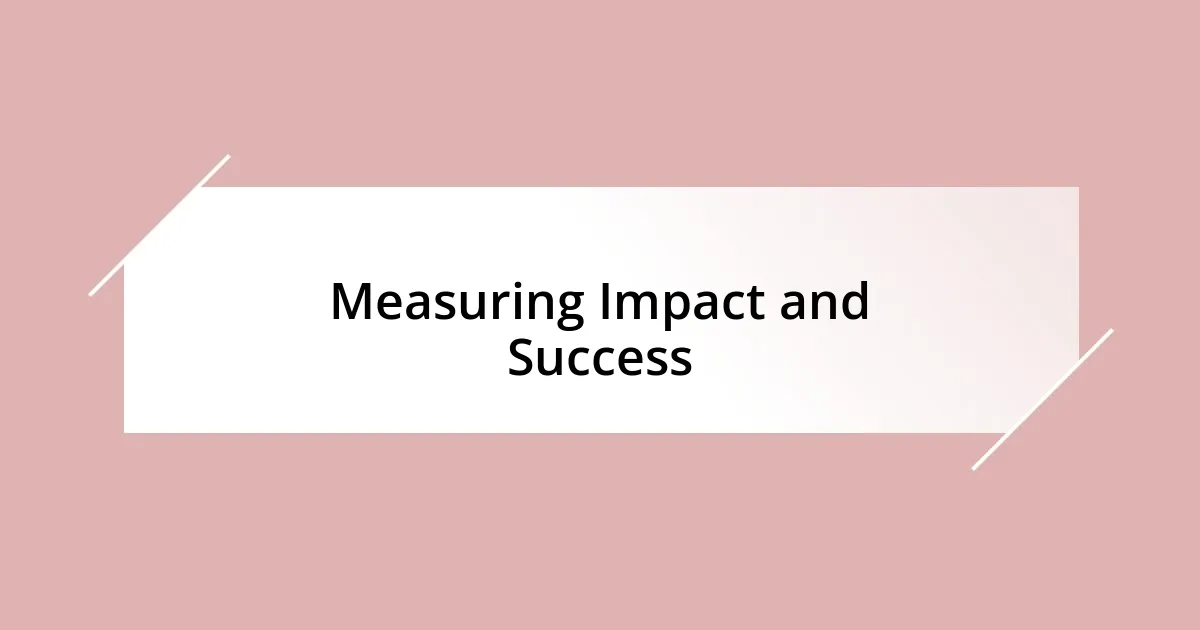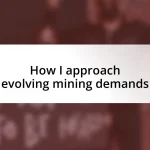Key takeaways:
- Environmental advocacy thrives on clear communication, collaboration, and persistence, enabling meaningful change.
- Building a strong community network fosters relationships that enhance collective action and resilience.
- Utilizing social media effectively amplifies advocacy efforts and encourages engagement through authentic storytelling.
- Measuring impact involves both quantifiable goals and personal stories that illustrate the broader influence of advocacy work.

Understanding Environmental Advocacy
Environmental advocacy is more than just a buzzword; it’s a powerful call to action for anyone who cares about our planet. I remember my first community clean-up event; the joy of meeting like-minded individuals made the experience unforgettable. Have you ever felt that sense of camaraderie while working towards a common goal? It’s that spirit of togetherness that fuels our passions for change.
At its core, environmental advocacy encompasses a variety of approaches—from grassroots activism to policy reform. I’ve seen firsthand how even small local efforts can spark significant change, especially when community members unite for a cause they believe in. What does it feel like to witness a community come alive through advocacy? It’s invigorating, like a shared heartbeat echoing across the landscape.
Understanding this movement involves recognizing the interconnectedness of environmental issues. Take climate change, for example; it doesn’t just affect wildlife and ecosystems but also human health and economies. When I first delved into this, I was struck by the enormity of the challenges we face. It left me wondering: how can we ensure that our advocacy resonates with those around us? Engaging people in meaningful discussions is key to fostering awareness and driving collective action.

Key Principles of Effective Advocacy
Advocacy is rooted in clear communication, ensuring that your message resonates with your audience. I recall a time when I presented at a local town hall about the importance of reducing plastic waste. The shift in energy in the room was palpable as I tailored my message to address the concerns of community members. It’s fascinating how a simple connection can elevate your cause and inspire action.
Another principle that I find invaluable is collaboration. Working with diverse groups fosters a more robust dialogue and amplifies your reach. I experienced this during a campaign that united various local organizations to promote renewable energy. The synergy we created was inspiring. When everyone contributes their strengths, the impact is powerful and profound.
Finally, persistence can’t be overlooked. Advocacy often is a marathon, not a sprint. I remember organizing multiple meetings about local conservation efforts, and, despite initial resistance, we eventually sparked a movement. It taught me that patience and determination often lead to meaningful change.
| Key Principle | Description |
|---|---|
| Clear Communication | Crafting messages that resonate with your audience increases engagement and inspires action. |
| Collaboration | Bringing together diverse groups amplifies voices and strengthens advocacy efforts. |
| Persistence | Committing to long-term goals and remaining resilient can lead to significant change. |

Building a Strong Community Network
Building a strong community network is crucial in environmental advocacy, as it cultivates relationships that foster support and action. I’ll never forget the warmth of my first local rally, where I was swept up not just in the cause, but in the collective spirit of everyone present. It’s in those moments, sharing stories over homemade banners and coffee, that I truly understood the impact of coming together. When we connect as a community, our individual passions blend into a powerful movement that drives change.
- Create Safe Spaces: Establish environments where community members feel comfortable sharing their ideas and concerns.
- Engage Regularly: Organize frequent gatherings—simple meet-ups or educational workshops—to maintain momentum and enthusiasm.
- Share Resources: Collaborate on sharing tools, information, and skills to empower each other.
- Celebrate Successes: Take time to acknowledge both small victories and larger achievements; it boosts morale and encourages ongoing participation.
- Stay Inclusive: Actively seek out diverse voices to represent various perspectives and broaden the network’s reach.
The beauty of a strong network lies in its resilience. One rainy day, during an event dedicated to reforesting a local park, a few devoted souls turned out, armed with umbrellas and shovels. It was a humbling reminder that commitment isn’t about numbers; it’s about heart. Witnessing that unwavering dedication solidified my belief in the power of community—when we stick together, even against the odds, we can nurture not just our environment, but also the relationships that sustain our efforts.

Utilizing Social Media for Change
Utilizing social media for change has become a cornerstone of modern advocacy. I vividly remember when I shared a video of a local beach cleanup on my social media platforms. The overwhelming response surprised me—within days, more people showed up to our next cleanup than ever before. It made me realize that digital outreach can amplify our efforts in a way that traditional methods often can’t.
I find it fascinating how social media allows us to tell our stories authentically. One post about my personal journey with plastic pollution resonated deeply with many, prompting a lively discussion in the comment section. It’s incredible to see individuals connect, share their stories, and commit to change simply by witnessing someone else’s passion. Isn’t it refreshing how a single post can ignite a spark of motivation in others?
Furthermore, social media isn’t just a platform for sharing information; it’s a tool for mobilization. I recall a specific instance when we organized a virtual rally to advocate for environmental policy changes. With just a few strategic posts and shares, we gathered thousands of participants from different backgrounds. The virtual space allowed for more voices to join in the conversation, showcasing that change can happen even when we’re physically apart. Could there be a more powerful reminder of our collective strength?

Engaging with Policymakers Effectively
Engaging effectively with policymakers requires a strategic approach rooted in clarity and relationship-building. I recall attending a town hall meeting where I had the chance to speak directly to a local representative. The nerves I felt faded as I articulated my vision for a greener community, focusing on the tangible benefits of proposed initiatives. The direct interaction opened a dialogue that felt impactful, reminding me that personalization is key; it shows policymakers that their constituents are not just voices in a crowd but passionate individuals with authentic stories.
Building rapport doesn’t end with that first interaction. I’ve learned that follow-ups—a simple email thanking them for their time or sharing additional insights—can solidify a connection. It’s a small gesture, but it keeps the conversation going and reinforces that their actions matter to someone. Have you ever had a conversation where you felt truly heard? That’s the feeling we want to create with policymakers. When they sense that their decisions can lead to real change, their motivation to act often increases.
Sharing facts, data, and personal narratives can be a game-changer in discussions with officials. I remember presenting research on local air quality during a meeting with city officials. By intertwining statistics with my own experiences of family health struggles, I noticed heads nodding, and the room shifted from formal to empathetic. It’s remarkable how connecting the dots between evidence and lived experiences can evoke a sense of urgency and responsibility among decision-makers. What stories are you ready to share to spark that same feeling?

Measuring Impact and Success
Measuring the impact and success of environmental advocacy can sometimes feel ambiguous, but I’ve found that setting clear, quantifiable goals is essential. For instance, after running a campaign aimed at reducing single-use plastics, we tracked how many businesses committed to alternatives. That tangible number brought a sense of achievement and clarity to our efforts, illustrating that our messaging resonated in a real-world context. Have you tried tracking metrics to gauge your efforts?
But beyond numbers, I believe in the stories that emerge from our advocacy. I recall a moment when a local school reached out to share how our educational workshops inspired them to launch their recycling program. Hearing about their initiative reminded me that impact isn’t always about metrics—it’s about the ripples we create in our communities. It prompts the question: how do we quantify the spark of inspiration?
Another approach I’ve embraced is gathering feedback from participants after events or campaigns. I once facilitated a community forum on sustainable practices. The feedback we received illuminated not only what worked but also areas for growth. Each comment painted a clearer picture of our collective success and challenges. Have you ever considered how valuable such reflections can be in shaping future initiatives?

Sharing Success Stories and Strategies
Sharing success stories in environmental advocacy is powerful. I remember a time when our group successfully campaigned for a community garden. One of the local families wrote to us, sharing how much the garden transformed their backyard into a vibrant space. Their heartfelt message reminded me that these efforts resonate deeply beyond the immediate impact—people feel more connected to their environment and each other. Can you think of a success story that brought a smile to your face?
It’s also essential to share strategies that worked for us. For instance, we hosted monthly clean-up events that not only beautified our parks but fostered community spirit. I still cherish the laughter and camaraderie we experienced, transforming strangers into friends united for a common cause. This makes me wonder: how can small, regular actions create lasting change in your community?
Engaging with others about our journeys can inspire new ideas and approaches. At one gathering, someone suggested we create short video clips showcasing participants’ personal stories and motivations. As we shared these clips on social media, I was astonished by the response! People from all walks of life reached out, eager to join us. What simple story can you share today that might encourage others to take action?














